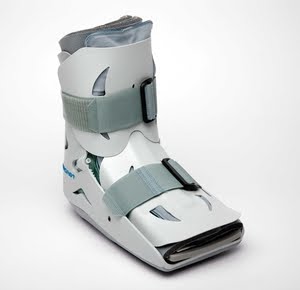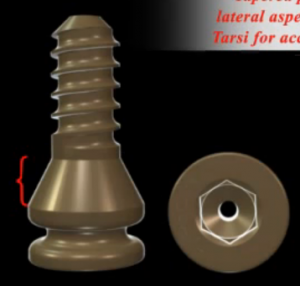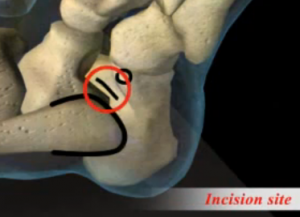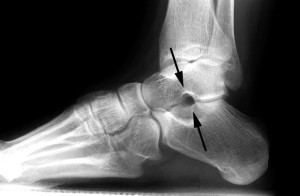In response to my post about another case where a woman reported that she seems to have gotten taller from going through the hormonally intense experience of pregnancy in the post “Another Case Of Pregnancy Causing Woman To Grow Taller And Increase In Height” a regular reader of the website named HeightSeeker asked a very interesting question which I wanted to answer in a post since it does have some potential height increasing results.
From Him…
“So does that mean that taking the hormone relaxin as a supplement possibly has the potential to increase the height of the ankle by 1 or 2 centimeters? resulting in the same increase in your overall height.
that would be amazing if true. Myself being flatfooted, im considering doing some kind of procedure on my feet to correct it as well that could possibly give me some height, afterall i only need 3 cms to be satisfied.
Michael do you know about any particular foot surgeries for flat feet that might result in height increase? I found this blog where this guy corrected his flat feet condition with Hyprocure implants, and he claims he gained about half an inch in height from this procedure.
http://hyprocure-surgery.
HeightSeeker’s interest in increasing height is slightly different than most people who come visit to the website. His focus is on doing some type of surgery which he is okay with. He is only after 3 cms so something like using the Hyaluronic Acid gel implant is completely acceptable. I would do more research on this surgery which I have never heard of called Hyprocure Surgery
From the Blog referenced…
 This guy wrote around a dozen posts documenting his journey from getting the surgery to the time when he is okay again, describing the recovery and physical therapy process.
This guy wrote around a dozen posts documenting his journey from getting the surgery to the time when he is okay again, describing the recovery and physical therapy process.
Some background information: This guy was at the time 33 years old. He has always had flat feet and this condition caused him a great deal of discomfort and pain. He has had to wear a custom orthotic since he was 17. The orthotic did decrease and relieve some of the pain but in his 20s, the orthotic caused him to develop lower back pain, sciatica, and knee problems. The chronic pain from the mid 20s turned into daily pain in the mid 30s. Every time he has to sit, he had to use a lower back support pillow. When he is standing, with or without the orthotic he develops pain and discomfort after just 20 minutes. His is also slouching due to the flat feet. He decided to go through with the surgery known as hyprocure since it seems to be less invasive and has less complications than something else known as alternate reconstructive flat foot surgery. He chose to go through with the surgery with a very well known and respected doctor named Dr. Jeffery Kass.
The Science Behind The Hyprocure Stent Implant for Flat Feet Correction Surgery
 This information is taken from the youtube video HERE. It seems that the stent is a relatively long metal screw that is being placed through the ankle bone to stabilize it. The tapered portion of this stent will be put through the canalis tarsi on the lateral side.
This information is taken from the youtube video HERE. It seems that the stent is a relatively long metal screw that is being placed through the ankle bone to stabilize it. The tapered portion of this stent will be put through the canalis tarsi on the lateral side.
As stated in the video….
The feet is extremely important for the entire body to maintain proper balance and weight distribution. The osseous alignment of the hind bone is crucial for the entire feet to maintain its function. Partial displacement of the talus aka the ankle bone on the hind foot bones is responsible for certain disorders like hyperpronation leading to increased strain and pain that can go all the way up the leg bones to the upper back area.
The hyprocure solution is an internal solution to an internal problem. The material of the stent is made from titatium. It is to stabilize the ankle bone which are on the hind foot bones in order to maintain the proper balance and weight distribution. Apparently external modalities seem to have trouble in accomplishing the same task. It seems that this stent is made of a type of material that will not fracture, unlike previous methods or designs.
 The surgery is invasive, and the stent involves putting the stent in a certain position of the feet right above the calcaneus. Note that the position will be extra-articular, so the actual stent is not placed in a joint but actually IN BETWEEN joints. The other way to think about the stent is that is will go on the bottom surface of the talus bone.
The surgery is invasive, and the stent involves putting the stent in a certain position of the feet right above the calcaneus. Note that the position will be extra-articular, so the actual stent is not placed in a joint but actually IN BETWEEN joints. The other way to think about the stent is that is will go on the bottom surface of the talus bone.
- A small incision is made over the sinus tarsie (not sure what that is yet). The interosseous talocalcaneal ligament is cut using scissors specifically made for doing tenotomy.
- A guide wire is placed into the canalis portion of the Sinus Tarsi.
- A trial sizer is inserted into the canalis and sinus portion of the Sinus Tarsi.
- After the stent is fit into place, the surgeon will move the feet around to make sure that the ankle area has over 4 degree of pronation. You want to make sure the ankle movement is not too much and not to stiff.
- What then happens is that larger and larger stent trial sizes are tried until the right size is found for the best level of pronation. The idea is that you want to find the trial size that is for around 2-3 degree of pronation.
- The result is that you want to find the trial size which leads to no more degrees of pronation. Then you choose the trial size that is right before that trial size.
- The right sized trial is then pushed partially into the sinus tarsi and the wire that was always embedded is removed.
- The implant is then fully implanted into the sinus tarsi until it is fully inside, and can not go in any further. You want to be pushing in the direction of the posterior side of the Medial Malleolus.
- You would still have the same level of movement for the talus in the tarsal mechanism. Thus, after a few weeks of recovery with the implant securely in place without a chance of increased pronation, you would have been able to realign the ankle bone.
So would going through with this type of surgery known as Hyprocure Stent Implant lead to height increase?
If a person is coming from the condition of flat feet then it indeed would lead to some height increase, which I would guess is usually only about 1/4-1/2 th of an inch.
The surgery is not done for any type of cosmetic reasons but only done for cosmetic reasons, mainly to reduce pain in the feet, legs, and lower which is caused by hind feet bone misalignment.
I would do slightly more research on what exactly is the Sinus Tarsi and where it is exactly located. Is seems to be the cavity that is right between the calcaneus and tarsi on the lateral area.
From the Tarsal Sinus article from Radiopaedia.org…
 The tarsal sinus is situated on the lateral side of the foot; distal and slightly anterior to the lateral malleolus. It is a space bordered by the neck of the talus and anterosuperior aspect of the calcaneus. The tarsal sinus opens medially, posterior the sustentaculum tali of the calcaneus, as a funnel-shaped tarsal canal. The sinus tarsi separates the anterior subtalar joint and posterior subtalar joint
The tarsal sinus is situated on the lateral side of the foot; distal and slightly anterior to the lateral malleolus. It is a space bordered by the neck of the talus and anterosuperior aspect of the calcaneus. The tarsal sinus opens medially, posterior the sustentaculum tali of the calcaneus, as a funnel-shaped tarsal canal. The sinus tarsi separates the anterior subtalar joint and posterior subtalar joint
If you look at the X-ray of the ordinary feet to the right then you would realize that the Sinus Tarsi is in fact HOLLOW with NO BONE TISSUE. This sinus is actually filled with ligaments of a certain sort. If we took the titanium based stent, we could put it in to stabilize the ankle area for better posture.
I would guess that a reasonable number of people who get the hyprocure implant surgery from flat feet pain would absolutely notice that they are at least a fraction of an inch taller. Due to how the degree of freedom works in the ankle, which is not a synovial joint, a large enough stent implant would push the talus and calcaneus farther apart. Since we see that the talus is in fact on top of the calcaneus, this would translate to some height increase as the none bone cavity is made bigger. The titanium based material is not supposed to fracture so it basically becomes a part of the body.
You can grow taller using this method, which is invasive. It would at most give a person 1/2-3/4 of an extra height in increase.

Thank you for investigating this subject further, So it seems i have found my solution. Your finale sentence of this post:
“You can grow taller using this method, which is invasive. It would at most give a person 1/2-3/4 of an extra height in increase.”
I assume you mean 1/2-3/4 of an extra Inch* when you say that. depending on the size of the implant you get, and how much it archs the heel.
Hopefully I get as much as possible out of this procedure which I will do as soon as possible. Even if it doesnt give me the full 3 cms, I will probably be able to get the rest with lsjl which I am still doing (for slightly more than 2 months now), Im pretty sure ive gained slightly more than 1 cm through lsjl already, so it should do the trick. Tyler supposedly got 4 cms in 9 months, so im hopeful.
Btw Michael, one thing I was wondering which you didnt touch upon, is the effect of relaxin on the feet. It seems we are still not sure why pregnant women some times grow in height, but if relaxin is the answer and that it increases the height of the feet, then it should in theory work as a supplement for non pregnant people as well, am i wrong?
Regards
I know I’m late to this, but I wanted to add some additional information. I experience severe overpronation of my feet and am scheduled for the HyProCure implant. I actually asked my surgeon, before finding this site, if I’d be taller after the procedure; unfortunately, his response was an emphatic “NO”. If you’re scheduled for foot surgery and wish to be taller, don’t get your hopes up.
I just happened on your comments about your impending operation.
My son who is 22 is seriously considering this procedure for flat feet, and we will need all the
information we can find about this procedure.
Would you be kind enough to share with us your experience and hopefully your improvement
from your pronation condition.
We would much appreciate this as it is rather difficult to find people who have had the procedure done.
Thank you and we do hope you are much better than before.
Sincerely,
Barbara Rooney
Hello,
I had this surgery on November 10, 2014, so I am still in the early stages, but I can say that my foot feels much more stable and I no longer have pain in that knee. The other knee of the uncorrected foot continues to have pain. I would highly recommend this surgery if you are having symptoms (pain/instability) that is not corrected by orthotics. Before I had the surgery, I had torn all 4 menisci in the knees and was starting to have pain in my hips.
I would strongly recommend not having the “triple arthrodesis” surgery, often called the “flat foot surgery”, as that is destructive and irreversible, limits/prevents side to side motion, and can cause arthritis in the other joints. Hyprocure is completely reversible because it is seated in a naturally occurring space in the foot and is held in place by scar tissue. The failure rate of the surgery is around 3-5%, in the unlikely event that your foot can’t adapt to the new position, the device can be removed and your foot should return to the presurgical position.
Here is the most informative blog I have read. Both the writer and I are patients of Dr. Kass…
http://hyprocure-surgery.blogspot.com/
Good luck!